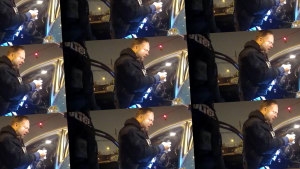These Police Body Camera Videos Just Cast Doubt On Dozens Of Gun And Drug Convictions
Getting the police to wear body cameras has been welcomed by both activists and law enforcement officials as a way of increasing transparency, especially in light of recent high-profile fatal shootings. But they’ve actually proven more illuminating at exposing a different type of police misconduct: Fake evidence. It isn’t a new problem in policing, but body cameras in Baltimore have given the public a high-definition glimpse into the phenomenon in recent weeks, with the emergence of videos allegedly showing officers planting drugs. City prosecutors are now re-examining hundreds of cases.
By Friday, state’s attorney for Baltimore Marilyn Mosby had thrown out 41 cases because of “credibility” concerns arising from a video her office released last month. Shot in January, the clip appeared to show an officer planting drugs in an abandoned lot as two other officers looked on.
This week, the city’s public defender’s office discovered another set of disturbing videos. Shot in November, one of them shows an officer appearing to plant something in the front seat of a suspect’s car during a traffic stop as six other officers stood by. That the officers may have been “working together to manufacture evidence,” as Mosby’s office described the video in a statement, was what was “most concerning” about the video, she told CBS Baltimore.
“I think they put something in my car,” Shamere Collins, 35, whose car appears in the new videos, told NBC News.
In the initial video, Officer Richard Pinheiro appears not to realize that his camera is recording as he places a bag of drugs inside a coffee can in a trash-strewn lot: the department’s body cameras feature a 30-second buffer, which means the devices automatically record the 30 seconds of video just before an officer presses the record button, though without audio.
Last week, Mosby announced the dismissal of felony drug and gun charges in dozens of cases that rely on the testimony of Pinheiro, and two other officers at the scene, Hovhannes Simonyan and Jamal Brunson. This week, her office said 27 cases were proceeding on the strength of “independent corroborative evidence” while 55 more were being reviewed. Pinheiro has been suspended, and the other two were placed on administrative duty amid an investigation.
The videos that surfaced this week date to a drug arrest on November 29, 2016. Police said they witnessed a man get into his girlfriend’s car with what they believed was a bag of drugs, so they stopped and searched the car and the two individuals.
“Your passenger is under arrest because your car smells like weed,” one officer says when the woman asks why she is being asked to get out of her car, in one video. “I’m putting handcuffs on you because there’s drugs in your car,” an officer says later. “You didn’t show me any drugs,” the woman says. In the videos, officers can be seen searching around the driver’s seat of the car for several minutes but finding nothing.
Then, 30 minutes later, separate body camera videos show one officer crouching near the seat as his colleagues watch. When he steps back, other officers can be seen switching on their cameras. This is when the audio kicks in. Again, the officers appear not to realize that the previous 30 seconds had been recorded prior to the cameras’ activation.
“Now?” someone says. Then another officer approaches the seat and quickly makes a discovery. “Oh, here you go,” he says, holding a black bag that allegedly contained marijuana. “That’s the weed smell right there.”
Shamere Collins, one of the suspects in the video, told NBC News she was a recreational marijuana smoker, but said she was shocked to learn the police discovered bags of weed and heroin in her car. “My mind — I went numb like — I didn’t know what was going on. They [were] telling me I was facing time and all this … so it’s like I felt numb. I didn’t know what to do.”
Engineering Or Reenacting?
The clips, released by Collins’s lawyer on Monday, prompted prosecutors to drop her case, as well as related charges against a defendant in another drug-related case, said the city’s public defender. The state’s attorney’s office also said it was requesting postponements on all cases requiring testimony from two officers involved in the new case, but warned not to jump to conclusions.
“Before we blanketly characterize their behavior as deceptive and/or a credibility issue, we referred the matter to the Internal Affairs Division of the Baltimore Police Department,” wrote Melba Saunders, a spokeswoman for the office. The department has launched an investigation, but has not named the six officers involved. None of them has been suspended, but two were referred to the department’s internal affairs division.
Police spokespeople described the videos as disturbing but suggested that officers may sometimes reenact previous searches for evidence when they haven’t caught the original discovery on camera. “I think it’s irresponsible to jump to a conclusion that the police officers were engaged in criminal misconduct,” commissioner Kevin Davis told reporters. “That’s a heavy allegation to make.”
In a memo he sent to the force on Wednesday, he instructed officers not to reenact evidence discovery. “In the event your body worn camera is not activated during the recovery of evidence, under no circumstances shall you attempt to recreate the recovery of evidence after re-activating your body worn camera,” his memo said. “If you must deactivate your body worn camera during an incident, merely explain the reasoning on camera (e.g., to protect the identity of a witness who wishes to remain anonymous, etc.).”
According to an audit by the department published earlier this year, of 3,290 recordings saved by some 500 officers, one-third of the inspection reports show violations because officers either did not record an encounter or store video as required. A spokesman said officers have been disciplined for violations of the policy. During the program’s first six months, 47 videos were sent to internal affairs for review of possible officer misconduct, according to the police website about the program.
More and more, body cameras are capturing the life on duty of police officers—from deadly use-of-force incidents and suspicious traffic stops to lesser-seen feats of heroism. The devices—which can cost a few hundred dollars per device, plus hundreds more in storage fees—have also caught officers behaving badly in non-violent ways. In a body camera video that emerged in April, a Pueblo, Colorado, officer named Seth Jensen was captured allegedly staging a drug find in a vehicle, sounding “surprised” when he finds cash and heroin. Felony drug and weapons charges were dismissed against the suspect, but no public action was taken against him. In October a veteran Denver police officer, Julan Archuleta, was caught allegedly stealing $1,200 in cash from a suspect’s car, again thanks to a camera he was wearing.
And an untold amount of evidence manipulation can happen off camera, too. In April, Massachusetts threw out more than 20,000 drug cases after a state chemist admitted to years of falsifying drug test results.
“The Truth” And Its Limits
Baltimore’s police force has been under scrutiny—and federal review—since 2014, when Freddy Gray died in the back of a police van. All the officers involved had their charges dropped or were acquitted by July 2016. But the following month, a Justice Department study found that the city’s police department “engages in a pattern or practice of conduct that violates the Constitution or federal law.”
Since body cameras were first deployed in May 2016—there are 1,500 deployed now, and 2,500 scheduled for next year—the city has witnessed a new kind of police transparency. In one prominent clip from earlier this year, an undercover officer was captured fatally shooting a suspect after he pointed a loaded handgun at the officer during a foot chase. The department released the video about a day after the daytime incident to demonstrate that the shooting was justified, and to forestall the potential public outcry in a city where trust in the police has worn thin.
The faith in cameras to improve police-community relations, or at least get closer to “the truth,” even inspired the slogan of the company that dominates the electric weapons and body camera business, and makes the cameras worn by Baltimore’s officers: “Protect Life, Protect Truth,” is how Axon, formerly Taser International, describes its mission.
At the same time, however, these videos—and the implicit assumption that there are more bad officers whose cameras did not capture them planting evidence—offer another sobering reminder about the limits of the technology. What’s captured on camera—if anything is captured at all—isn’t always what really happened. We’ll keep getting those reminders, and we’ll likely need them.
“This is kind of a learning and a trial period, right?” Mosby, the state’s attorney for Baltimore, said last week. “All of the body-worn cameras haven’t even been implemented, and I think that we’re going to go through growing pains.”
Despite the transparency they promise, the videos are also reminders that they’re only as useful as their policies make them. Like that of an increasing number of departments, Baltimore’s body camera policy gives officers wide discretion about when to switch their cameras off due to privacy concerns. If the officers in the videos were required to keep their cameras rolling during the entire interaction, it might be more difficult to manufacture evidence, and easier to determine what happened.
Michael D. White, a professor in ASU’s School of Criminology and Criminal Justice and co-director of training and technical assistance for the Justice Department’s Body-Worn Camera Policy and Implementation Program, points to the case last month of the Minneapolis police officer who shot and killed a citizen. The officer had a body-worn camera, but he did not activate it. “One of the concerns that departments are wrestling with right now is how are they going to monitor officer activation compliance and what are they going to do with officers with low compliance rates? Is there going to be an informal response? Graduated discipline?” he says. “Clearly for me, that’s a big one. Departments are going to have to develop plans and policies to address this issue.”
Another hurdle to transparency is a Maryland Court of Appeals decision from 2015 that held that victims of police misconduct lack the right to learn about investigations into their complaints, including whether discipline was ultimately imposed. The ACLU of Maryland has sought to pressure the legislature to give the public access to police misconduct records, but the Maryland State Police successfully argued in court that those are confidential “personnel records.”
There’s another paradox in Baltimore’s body camera policy, say civil rights advocates, one that’s increasingly common across the country: even as the city’s officers are recording tens of thousands of hours of video a week, state law keeps police videos out of public records and out of public view, at least until city officials decide to release them.
After the discovery of the new videos, Debbie Katz Levi, head of the city public defender’s Special Litigation Section, slammed the state’s attorney’s office for poor communication about the videos of concern that have been discovered so far. “The lack of transparency to the public and refusal to disclose to the defense both prejudices defendants and violates the prosecutor’s constitutional obligations,” she said. “Hundreds of individuals are awaiting trial on cases that rely on these officers, and hundreds more have likely been convicted based on their testimony.”
Baltimore is reeling again from the discovery of videos showing police planting evidence, which has led the state’s attorney to review over a hundred cases.
Getting the police to wear body cameras has been welcomed by both activists and law enforcement officials as a way of increasing transparency, especially in light of recent high-profile fatal shootings. But they’ve actually proven more illuminating at exposing a different type of police misconduct: Fake evidence. It isn’t a new problem in policing, but body cameras in Baltimore have given the public a high-definition glimpse into the phenomenon in recent weeks, with the emergence of videos allegedly showing officers planting drugs. City prosecutors are now re-examining hundreds of cases.
Fast Company , Read Full Story
(17)







